Characteristics and Estimation of Dew in the Loess Hilly Region of Northern Shaanxi Province, China
Abstract
1. Introduction
2. Materials and Methods
2.1. Study Area
2.2. Experimental Design
2.3. Data Processing
2.3.1. Dew Amount
2.3.2. Dew Point
2.3.3. Cloud Data
2.3.4. Relevant Definitions
2.4. Dew Estimation
2.4.1. Beysens Model
2.4.2. Error Evaluation
2.5. Data Analysis
3. Results
3.1. Dew Characteristics
3.1.1. Daily Variation of Dew
3.1.2. Monthly Dew Variation
3.1.3. Annual Dew Variation
3.2. Influencing Factors of Dew
3.2.1. Difference between Air Temperature and Dew point
3.2.2. Relative Humidity
3.2.3. Wind Speed and Direction
3.3. Influence of Dew on Soil Moisture
3.4. Simulation and Model Evaluation of Dew
4. Discussion
4.1. Characteristics of Dew in Loess Hilly Areas
4.2. Factors Affecting Dew in Loess Hilly Areas
4.3. Applicability of the Beysens Model
4.4. Impacts of Dew on Ecosystems
5. Conclusions
Author Contributions
Funding
Institutional Review Board Statement
Informed Consent Statement
Data Availability Statement
Conflicts of Interest
References
- Cao, S.; Chen, L.; Yu, X. Impact of China’s Grain for Green Project on the landscape of vulnerable arid and semi-arid agricultural regions: A case study in northern Shaanxi Province. J. Appl. Ecol. 2009, 46, 536–543. [Google Scholar] [CrossRef]
- Zhao, Y.; Xu, M. Runoff and Soil Loss from Revegetated Grasslands in the Hilly Loess Plateau Region, China: Influence of Biocrust Patches and Plant Canopies. J. Hydrol. Eng. 2013, 18, 387–393. [Google Scholar] [CrossRef]
- Gao, L.; Bowker, M.A.; Xu, M.; Sun, H.; Tuo, D.; Zhao, Y. Biological soil crusts decrease erodibility by modifying inherent soil properties on the Loess Plateau, China. Soil Biol. Biochem. 2017, 105, 49–58. [Google Scholar] [CrossRef]
- Xiao, B.; Ma, S.; Hu, K. Moss biocrusts regulate surface soil thermal properties and generate buffering effects on soil temperature dynamics in dryland ecosystem. Geoderma 2019, 351, 9–24. [Google Scholar] [CrossRef]
- Tsafaras, I.; Campen, J.B.; de Zwart, H.F.; Voogt, W.; Harbi, A.A.; Assaf, K.A.; Abdelaziz, M.E.; Qaryouti, M.; Stanghellini, C. Quantifying the trade-off between water and electricity for tomato production in arid environments. Agric. Water Manag. 2022, 271, 107819. [Google Scholar] [CrossRef]
- Kidron, G.J. Analysis of dew precipitation in three habitats within a small arid drainage basin, Negev Highlands, Israel. Atmos. Res. 2000, 55, 257–270. [Google Scholar] [CrossRef]
- Fang, X.; Zhao, W.; Wang, L.; Feng, Q.; Ding, J.; Liu, Y.; Zhang, X. Variations of deep soil moisture under different vegetation types and influencing factors in a watershed of the Loess Plateau, China. Hydrol. Earth Syst. Sci. 2016, 20, 3309–3323. [Google Scholar] [CrossRef]
- Hill, A.J.; Dawson, T.E.; Shelef, O.; Rachmilevitch, S. The role of dew in Negev Desert plants. Oecologia 2015, 178, 317–327. [Google Scholar] [CrossRef]
- Jacobs, A.F.G.; Heusinkveld, B.G.; Berkowicz, S. Dew deposition and drying in a desert system: A simple simulation model. J. Arid. Environ. 1999, 42, 211–222. [Google Scholar] [CrossRef]
- Hao, X.-M.; Li, C.; Guo, B.; Ma, J.-X.; Ayup, M.; Chen, Z.-S. Dew formation and its long-term trend in a desert riparian forest ecosystem on the eastern edge of the Taklimakan Desert in China. J. Hydrol. 2012, 472–473, 90–98. [Google Scholar] [CrossRef]
- Agam, N.; Berliner, P.R. Dew formation and water vapor adsorption in semi-arid environments—A review. J. Arid Environ. 2006, 65, 572–590. [Google Scholar] [CrossRef]
- Wang, L.; Kaseke, K.F.; Seely, M.K. Effects of non-rainfall water inputs on ecosystem functions. Wiley Interdiscip. Rev. Water 2017, 4, e1179. [Google Scholar] [CrossRef]
- Feng, T.; Zhang, L.; Chen, Q.; Ma, Z.; Wang, H.; Shangguan, Z.; Wang, L.; He, J.-S. Dew formation reduction in global warming experiments and the potential consequences. J. Hydrol. 2021, 593, 12589. [Google Scholar] [CrossRef]
- Kidron, G.J.; Starinsky, A. Measurements and ecological implications of non-rainfall water in desert ecosystems—A review. Ecohydrology 2019, 12, e2121. [Google Scholar] [CrossRef]
- Ninari, N.; Berliner, P.R. The role of dew in the water and heat balance of bare loess soil in the Negev Desert: Quantifying the actual dew deposition on the soil surface. Atmos. Res. 2002, 64, 323–334. [Google Scholar] [CrossRef]
- Guo, X.; Wang, Y.; Yan, H.; Liu, P.; Tian, Y.; Shang, G.; Jin, C.; Zha, T. Dew/hoar frost on the canopies and underlying surfaces of two typical desert shrubs in Northwest China and their relevance to drought. J. Hydrol. 2022, 609, 127880. [Google Scholar] [CrossRef]
- Jia, Z.; Wang, Z.; Wang, H. Characteristics of Dew Formation in the Semi-Arid Loess Plateau of Central Shaanxi Province, China. Water 2019, 11, 126. [Google Scholar] [CrossRef]
- Cosh, M.H.; Kabela, E.D.; Hornbuckle, B.; Gleason, M.L.; Jackson, T.J.; Prueger, J.H. Observations of dew amount using in situ and satellite measurements in an agricultural landscape. Agric. For. Meteorol. 2009, 149, 1082–1086. [Google Scholar] [CrossRef]
- Gao, Z.; Shi, W.; Wang, X.; Wang, Y. Non-rainfall water contributions to dryland jujube plantation evapotranspiration in the Hilly Loess Region of China. J. Hydrol. 2020, 583, 124604. [Google Scholar] [CrossRef]
- Khabbazan, S.; Steele-Dunne, S.C.; Vermunt, P.; Judge, J.; Vreugdenhil, M.; Gao, G. The influence of surface canopy water on the relationship between L-band backscatter and biophysical variables in agricultural monitoring. Remote Sens. Environ. 2022, 268, 112789. [Google Scholar] [CrossRef]
- Binks, O.; Mencuccini, M.; Rowland, L.; da Costa, A.C.L.; de Carvalho, C.J.R.; Bittencourt, P.; Eller, C.; Teodoro, G.S.; Carvalho, E.J.M.; Soza, A.; et al. Foliar water uptake in Amazonian trees: Evidence and consequences. Global Chang. Biol. 2019, 25, 2678–2690. [Google Scholar] [CrossRef]
- Allen, R.G.; Pereira, L.S.; Raes, D.; Smith, M. Crop Evapotranspiration: Guidelines for Computing Crop Water Requirements; FAO: Rome, Italy, 1998. [Google Scholar]
- Papale, D.; Reichstein, M.; Aubinet, M.; Canfora, E.; Bernhofer, C.; Kutsch, W.L.; Longdoz, B.; Rambal, S.; Valentini, R.; Vesala, T.; et al. Towards a standardized processing of Net Ecosystem Exchange measured with eddy covariance technique: Algorithms and uncertainty estimation. Biogeosciences 2006, 3, 571–583. [Google Scholar] [CrossRef]
- Tomaszkiewicz, M.; Abou Najm, M.; Beysens, D.; Alameddine, I.; Bou Zeid, E.; El-Fadel, M. Projected climate change impacts upon dew yield in the Mediterranean basin. Sci. Total Environ. 2016, 566–567, 1339–1348. [Google Scholar] [CrossRef] [PubMed]
- Lekouch, I.; Lekouch, K.; Muselli, M.; Mongruel, A.; Kabbachi, B.; Beysens, D. Rooftop dew, fog and rain collection in southwest Morocco and predictive dew modeling using neural networks. J. Hydrol. 2012, 448–449, 60–72. [Google Scholar] [CrossRef]
- Beysens, D. Estimating dew yield worldwide from a few meteo data. Atmos. Res. 2016, 167, 146–155. [Google Scholar] [CrossRef]
- Zheng, Y.; Bai, H.; Huang, Z.; Tian, X.; Nie, F.-Q.; Zhao, Y.; Zhai, J.; Jiang, L. Directional water collection on wetted spider silk. Nature 2010, 463, 640–643. [Google Scholar] [CrossRef] [PubMed]
- Pan, Z.; Pitt, W.G.; Zhang, Y.; Wu, N.; Tao, Y.; Truscott, T.T. The upside-down water collection system of Syntrichia caninervis. Nat. Plants 2016, 2, 16076. [Google Scholar] [CrossRef] [PubMed]
- Tuure, J.; Korpela, A.; Hautala, M.; Rautkoski, H.; Hakojärvi, M.; Mikkola, H.; Duplissy, J.; Pellikka, P.; Petäjä, T.; Kulmala, M.; et al. Comparing plastic foils for dew collection: Preparatory laboratory-scale method and field experiment in Kenya. Biosyst. Eng. 2020, 196, 145–158. [Google Scholar] [CrossRef]
- Kool, D.; Agra, E.; Drabkin, A.; Duncan, A.; Fendinat, P.P.; Leduc, S.; Lupovitch, G.; Nambwandja, A.N.; Ndilenga, N.S.; Nguyễn Thị, T.; et al. The overlooked non-rainfall water input sibling of fog and dew: Daily water vapor adsorption on a !Nara hummock in the Namib Sand Sea. J. Hydrol. 2021, 598, 126420. [Google Scholar] [CrossRef]
- Riedl, A.; Li, Y.; Eugster, J.; Buchmann, N.; Eugster, W. Technical note: High-accuracy weighing micro-lysimeter system for long-term measurements of non-rainfall water inputs to grasslands. Hydrol. Earth Syst. Sci. 2022, 26, 91–116. [Google Scholar] [CrossRef]
- Gerlein-Safdi, C.; Koohafkan, M.C.; Chung, M.; Rockwell, F.E.; Thompson, S.; Caylor, K.K. Dew deposition suppresses transpiration and carbon uptake in leaves. Agric. For. Meteorol. 2018, 259, 305–316. [Google Scholar] [CrossRef]
- Juřička, D.; Pecina, V.; Kusbach, A.; Vlček, V.; Novotná, J.; Pařílková, J.; Otgonsuren, B.; Brtnický, M.; Kynický, J. Thermal regime of semi-natural dew collector’s perspective for afforestation of semi-arid landscapes. Environ. Technol. Innov. 2020, 20, 101125. [Google Scholar] [CrossRef]
- Maestre-Valero, J.F.; Martin-Gorriz, B.; Martínez-Alvarez, V. Dew condensation on different natural and artificial passive surfaces in a semiarid climate. J. Arid Environ. 2015, 116, 63–70. [Google Scholar] [CrossRef]
- Jacobs, A.F.G.; Heusinkveld, B.G.; Wichink Kruit, R.J.; Berkowicz, S.M. Contribution of dew to the water budget of a grassland area in the Netherlands. Water Resour. Res. 2006, 42, W03415. [Google Scholar] [CrossRef]
- Zhang, Q.; Wang, S.; Yang, F.-L.; Yue, P.; Yao, T.; Wang, W.-Y. Characteristics of Dew Formation and Distribution, and Its Contribution to the Surface Water Budget in a Semi-Arid Region in China. Boundary-Layer Meteorol. 2015, 154, 317–331. [Google Scholar] [CrossRef]
- Kidron, G.J. Altitude dependent dew and fog in the Negev Desert, Israel. Agric. For. Meteorol. 1999, 96, 1–8. [Google Scholar] [CrossRef]
- Gotsch, S.G.; Asbjornsen, H.; Holwerda, F.; Goldsmith, G.R.; Weintraub, A.E.; Dawson, T.E. Foggy days and dry nights determine crown-level water balance in a seasonal tropical Montane cloud forest. Plant Cell Environ. 2014, 37, 261–272. [Google Scholar] [CrossRef]
- Zhuang, Y.; Zhao, W.; Luo, L.; Wang, L. Dew formation characteristics in the gravel desert ecosystem and its ecological roles on Reaumuria soongorica. J. Hydrol. 2021, 603, 126932. [Google Scholar] [CrossRef]
- Jia, Z.; Lei, R.; Liu, Y.; Liu, P.; Wang, Z.; Chang, Y.; Wei, W. Spatial–Temporal Variations and the Driving Factors of Vegetation Coverage in the Loess Hilly and Gully Region of China. Forests 2023, 14, 1238. [Google Scholar] [CrossRef]
- Zhao, D.; Xu, M.; Liu, G.; Yao, X.; Tuo, D.; Zhang, R.; Xiao, T.; Peng, G. Quantification of soil aggregate microstructure on abandoned cropland during vegetative succession using synchrotron radiation-based micro-computed tomography. Soil Tillage Res. 2017, 165, 239–246. [Google Scholar] [CrossRef]
- Hua, L.; Gao, J.; Zhou, M.; Bai, S. Impacts of Relative Elevation on Soil Nutrients and Apple Quality in the Hilly-Gully Region of the Loess Plateau, China. Sustainability 2021, 13, 1293. [Google Scholar] [CrossRef]
- Feng, Q.; Dong, S.; Duan, B. The Effects of Land-Use Change/Conversion on Trade-Offs of Ecosystem Services in Three Precipitation Zones. Sustainability 2021, 13, 13306. [Google Scholar] [CrossRef]
- VP-3 Operators Manual; Decagon Devices, Inc.: Pullman, WA, USA, 2015; Volume 8–9.
- Li, Q.; Liu, J.; Wang, S.; Guo, Y.; Han, X.; Li, Q.; Cheng, Y.; Dong, Z.; Li, X.; Zhang, X. Numerical insights into factors affecting collapse behavior of horizontal wellbore in clayey silt hydrate-bearing sediments and the accompanying control strategy. Ocean Eng. 2024, 297, 117029. [Google Scholar] [CrossRef]
- Li, Q.; Wang, F.; Wang, Y.; Forson, K.; Cao, L.; Zhang, C.; Zhou, C.; Zhao, B.; Chen, J. Experimental investigation on the high-pressure sand suspension and adsorption capacity of guar gum fracturing fluid in low-permeability shale reservoirs: Factor analysis and mechanism disclosure. Environ. Sci. Pollut. Res. 2022, 29, 53050–53062. [Google Scholar] [CrossRef] [PubMed]
- Lawrence, M.G. The Relationship between Relative Humidity and the Dewpoint Temperature in Moist Air: A Simple Conversion and Applications. Bull. Am. Meteorol. Soc. 2005, 86, 225–234. [Google Scholar] [CrossRef]
- Alduchov, O.A.; Eskridge, R.E. Improved Magnus form approximation of saturation vapor pressure. J. Appl. Meteorol. 1996, 35, 601–609. [Google Scholar] [CrossRef]
- Copernicus Climate Data Store. Available online: https://cds.climate.copernicus.eu (accessed on 10 January 2024).
- WMO. Manual on Codes. Part A—Alphanumeric Codes; Secretariat of the World Meteorological Organization: Geneva, Switzerland, 1995. [Google Scholar]
- Kotarba, A.Z. Inconsistency of surface-based (SYNOP) and satellite-based (MODIS) cloud amount estimations due to the interpretation of cloud detection results. Int. J. Clim. 2017, 37, 4092–4104. [Google Scholar] [CrossRef]
- Muselli, M.; Lekouch, I.; Beysens, D. Physical and Chemical Characteristics of Dew and Rain in North-West Africa with Focus on Morocco: Mapping Past and Future Evolution (2005–2100). Atmosphere 2022, 13, 1974. [Google Scholar] [CrossRef]
- Berger, X.; Bathiebo, J.; Kieno, F.; Awanou, C.N. Clear sky radiation as a function of altitude. Renew. Energ. 1992, 2, 139–157. [Google Scholar] [CrossRef]
- Top, C.B. A Generalized Split-Step Angular Spectrum Method for Efficient Simulation of Wave Propagation in Heterogeneous Media. IEEE Trans. Ultrason. Ferroelectr. Freq. Control. 2021, 68, 2687–2696. [Google Scholar] [CrossRef] [PubMed]
- Franceschelli, L.; Ciricugno, C.; Di Lorenzo, M.; Romani, A.; Berardinelli, A.; Tartagni, M.; Correale, R. Real-time gas mass spectroscopy by multivariate analysis. Sci. Rep. 2023, 13, 6059. [Google Scholar] [CrossRef]
- Kang, Y.-S.; Goldman, S.; Moorhouse, K.; Bolte, J. Evaluation of a coplanar 6a3ω configuration in the Hybrid III 50th percentile male head. Traffic Inj. Prev. 2017, 18, S129–S135. [Google Scholar] [CrossRef] [PubMed][Green Version]
- Fang, X.; Pomeroy, J.W. Impact of antecedent conditions on simulations of a flood in a mountain headwater basin. Hydrol. Process. 2016, 30, 2754–2772. [Google Scholar] [CrossRef]
- Mobini, N.; Malekzadeh, M.; Haghighatkhah, H.; Saligheh Rad, H. A hybrid (iron–fat–water) phantom for liver iron overload quantification in the presence of contaminating fat using magnetic resonance imaging. Magn. Reson. Mater. Phy. 2019, 33, 385–392. [Google Scholar] [CrossRef] [PubMed]
- Burgund, D.; Nikolovski, S.; Galić, D.; Maravić, N. Pearson Correlation in Determination of Quality of Current Transformers. Sensors 2023, 23, 2704. [Google Scholar] [CrossRef] [PubMed]
- Liu, Y.; Wu, J.; Huang, T.; Nie, W.; Jia, Z.; Gu, Y.; Ma, X. Study on the relationship between regional soil desertification and salinization and groundwater based on remote sensing inversion: A case study of the windy beach area in Northern Shaanxi. Sci. Total Environ. 2024, 912, 168854. [Google Scholar] [CrossRef]
- Salau, O.A.; Lawson, T.L. Dewfall features of a tropical station: The case of Onne (Port Hartcourt), Nigeria. Theor. Appl. Climatol. 1986, 37, 233–240. [Google Scholar] [CrossRef]
- Fang, J. Variability in condensation water and its determinants in arid regions of north-western China. Ecohydrology 2020, 13, e2226. [Google Scholar] [CrossRef]
- Heusser, K.; Heusser, R.; Jordan, J.; Urechie, V.; Diedrich, A.; Tank, J. Baroreflex Curve Fitting Using a WYSIWYG Boltzmann Sigmoidal Equation. Front. Neurosci. 2021, 15, 697582. [Google Scholar] [CrossRef]
- Scherm, H.; Bruggen, A.H.C.v. Sensitivity of simulated dew duration to meteorological variations in different climatic regions of California. Agric. For. Meteorol. 1993, 66, 229–245. [Google Scholar] [CrossRef]
- Guo, X.; Zha, T.; Jia, X.; Wu, B.; Feng, W.; Xie, J.; Gong, J.; Zhang, Y.; Peltola, H. Dynamics of Dew in a Cold Desert-Shrub Ecosystem and Its Abiotic Controls. Atmosphere 2016, 7, 32. [Google Scholar] [CrossRef]
- Zangvil, A. Six years of dew observations in the Negev Desert, Israel. J. Arid Environ. 1996, 32, 361–371. [Google Scholar] [CrossRef]
- Kaseke, K.F.; Wang, L.X.; Seely, M.K. Nonrainfall water origins and formation mechanisms. Sci. Adv. 2017, 3, e1603131. [Google Scholar] [CrossRef] [PubMed]
- Sharan, G.; Beysens, D.; Milimouk-Melnytchouk, I. A study of dew water yields on Galvanized iron roofs in Kothara (North-West India). J. Arid Environ. 2007, 69, 259–269. [Google Scholar] [CrossRef]
- Li, S.L.; Bowker, M.A.; Xiao, B. Biocrusts enhance non-rainfall water deposition and alter its distribution in dryland soils. J. Hydrol. 2021, 595, 126050. [Google Scholar] [CrossRef]
- Agam, N.; Berliner, P. Diurnal Water Content Changes in the Bare Soil of a Coastal Desert. J. Hydrometeorol. 2004, 5, 922–933. [Google Scholar] [CrossRef]
- Wang, X.P.; Pan, Y.X.; Hu, R.; Zhang, Y.F.; Zhang, H. Condensation of water vapour on moss-dominated biological soil crust, NW China. J. Earth Syst. Sci. 2014, 123, 297–305. [Google Scholar] [CrossRef]
- Muselli, M.; Beysens, D.; Marcillat, J.; Milimouk, I.; Nilsson, T.; Louche, A. Dew water collector for potable water in Ajaccio (Corsica Island, France). Atmos. Res. 2002, 64, 297–312. [Google Scholar] [CrossRef]
- Vuollekoski, H.; Vogt, M.; Sinclair, V.A.; Duplissy, J.; Järvinen, H.; Kyrö, E.M.; Makkonen, R.; Petäjä, T.; Prisle, N.L.; Räisänen, P.; et al. Estimates of global dew collection potential on artificial surfaces. Hydrol. Earth Syst. Sci. 2015, 19, 601–613. [Google Scholar] [CrossRef]
- Liu, M.; Cen, Y.; Wang, C.; Gu, X.; Bowler, P.; Wu, D.; Zhang, L.; Jiang, G.; Beysens, D. Foliar uptake of dew in the sandy ecosystem of the Mongolia Plateau: A life-sustaining and carbon accumulation strategy shared differently by C3 and C4 grasses. Agric. For. Meteorol. 2020, 287, 107941. [Google Scholar] [CrossRef]
- Jia, R.L.; Li, X.R.; Liu, L.C.; Pan, Y.X.; Gao, Y.H.; Wei, Y.P. Effects of sand burial on dew deposition on moss soil crust in a revegetated area of the Tennger Desert, Northern China. J. Hydrol. 2014, 519, 2341–2349. [Google Scholar] [CrossRef]
- Zhuang, Y.; Zhao, W. Dew formation and its variation in Haloxylon ammodendron plantations at the edge of a desert oasis, northwestern China. Agric. For. Meteorol. 2017, 247, 541–550. [Google Scholar] [CrossRef]
- Kidron, G.J.; Kronenfeld, R. Assessing the effect of micro-lysimeters on NRWI: Do micro-lysimeters adequately represent the water input of natural soil? J. Hydrol. 2017, 548, 382–390. [Google Scholar] [CrossRef]
- Aguirre-Gutiérrez, C.A.; Holwerda, F.; Goldsmith, G.R.; Delgado, J.; Yepez, E.; Carbajal, N.; Escoto-Rodríguez, M.; Arredondo, J.T. The importance of dew in the water balance of a continental semiarid grassland. J. Arid Environ. 2019, 168, 26–35. [Google Scholar] [CrossRef]
- Munné-Bosch, S.; Alegre, L. Role of Dew on the Recovery of Water-Stressed Melissa officinalis L. Plants. J. Plant Physiol. 1999, 154, 759–766. [Google Scholar] [CrossRef]
- Eller, C.B.; Lima, A.L.; Oliveira, R.S. Foliar uptake of fog water and transport belowground alleviates drought effects in the cloud forest tree species, Drimys brasiliensis (Winteraceae). New Phytol. 2013, 199, 151–162. [Google Scholar] [CrossRef] [PubMed]
- Dawson, T.E.; Goldsmith, G.R. The value of wet leaves. New Phytol. 2018, 219, 1156–1169. [Google Scholar] [CrossRef]
- Zhuang, Y.; Ratcliffe, S. Relationship between dew presence and Bassia dasyphylla plant growth. J. Arid Land 2012, 4, 11–18. [Google Scholar] [CrossRef][Green Version]
- Wang, X.; Gao, Z.Y.; Wang, Y.K.; Wang, Z.; Jin, S.S. Dew measurement and estimation of rain-fed jujube (Zizyphus jujube Mill) in a semi-arid loess hilly region of China. J. Arid Land 2017, 9, 547–557. [Google Scholar] [CrossRef]
- Ye, Y.; Zhou, K.; Song, L.; Jin, J.; Peng, S. Dew amounts and its correlations with meteorological factors in urban landscapes of Guangzhou, China. Atmos. Res. 2007, 86, 21–29. [Google Scholar] [CrossRef]
- Gutterman, Y.; Shem-Tov, S. Mucilaginous seed coat structure of Carrichtera annua and Anastatica hierochuntica from the Negev Desert highlands of Israel, and its adhesion to the soil crust. J. Arid Environ. 1997, 35, 695–705. [Google Scholar] [CrossRef]
- McHugh, T.A.; Morrissey, E.M.; Reed, S.C.; Hungate, B.A.; Schwartz, E. Water from air: An overlooked source of moisture in arid and semiarid regions. Sci. Rep. 2015, 5, 13767. [Google Scholar] [CrossRef] [PubMed]
- Rao, B.D.; Liu, Y.; Wang, W.; Hu, C.; Dun-hai, L.; Lan, S. Influence of dew on biomass and photosystem II activity of cyanobacterial crusts in the Hopq Desert, northwest China. Soil Biol. Biochem. 2009, 41, 2387–2393. [Google Scholar] [CrossRef]
- Parker, A.R.; Lawrence, C.R. Water capture by a desert beetle. Nature 2001, 414, 33–34. [Google Scholar] [CrossRef]
- Gliksman, D.; Rey, A.; Seligmann, R.; Dumbur, R.; Sperling, O.; Navon, Y.; Haenel, S.; De Angelis, P.; Arnone, J.A.; Grünzweig, J.M. Biotic degradation at night, abiotic degradation at day: Positive feedbacks on litter decomposition in drylands. Glob. Chang Biol. 2017, 23, 1564–1574. [Google Scholar] [CrossRef]
- Kaseke, K.F.; Wang, L. Fog and Dew as Potable Water Resources: Maximizing Harvesting Potential and Water Quality Concerns. Geohealth 2018, 2, 327–332. [Google Scholar] [CrossRef]
- Ben-Asher, J.; Alpert, P.; Ben-Zvi, A. Dew is a major factor affecting vegetation water use efficiency rather than a source of water in the eastern Mediterranean area. Water Resour. Res. 2010, 46, W10532. [Google Scholar] [CrossRef]
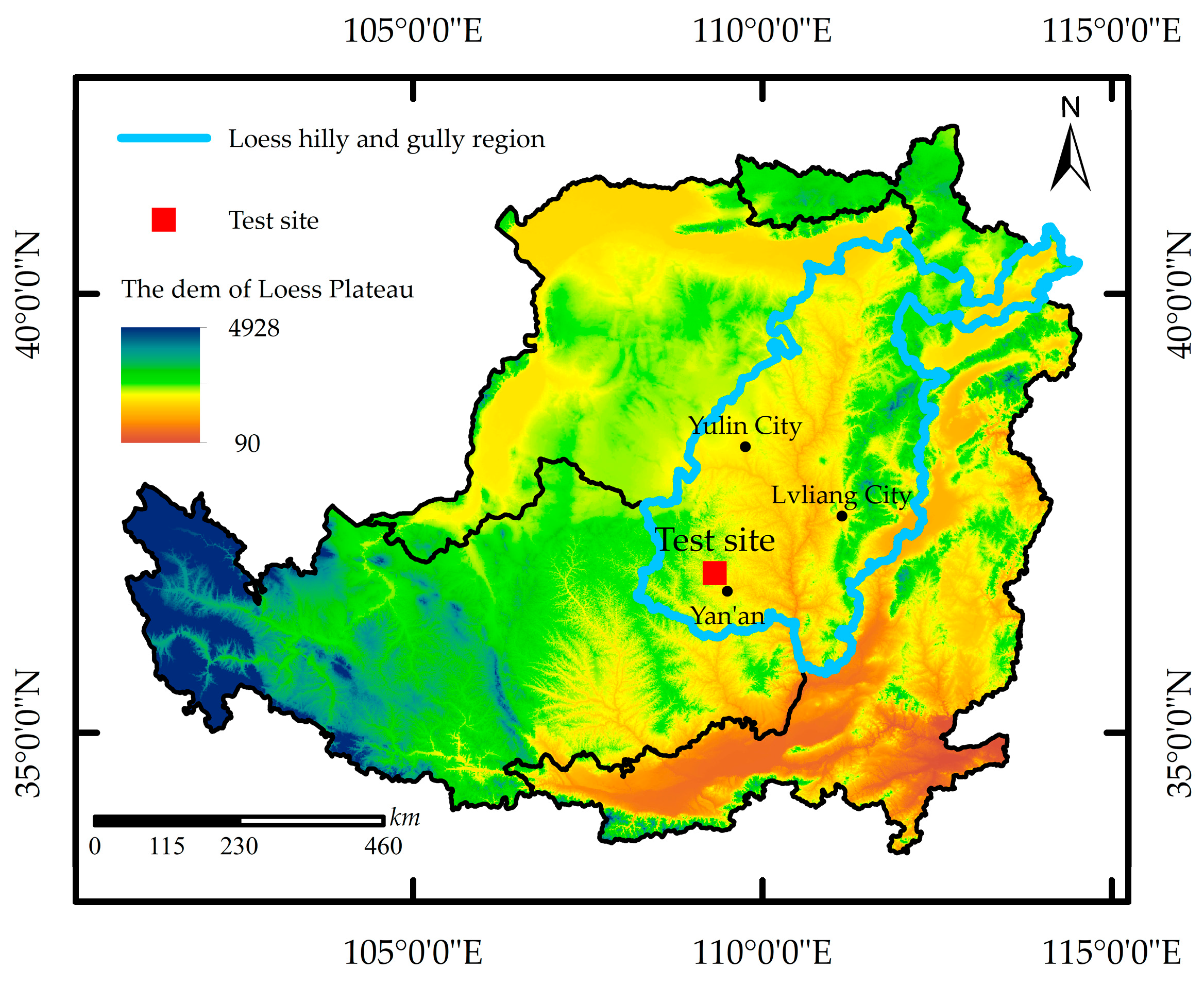
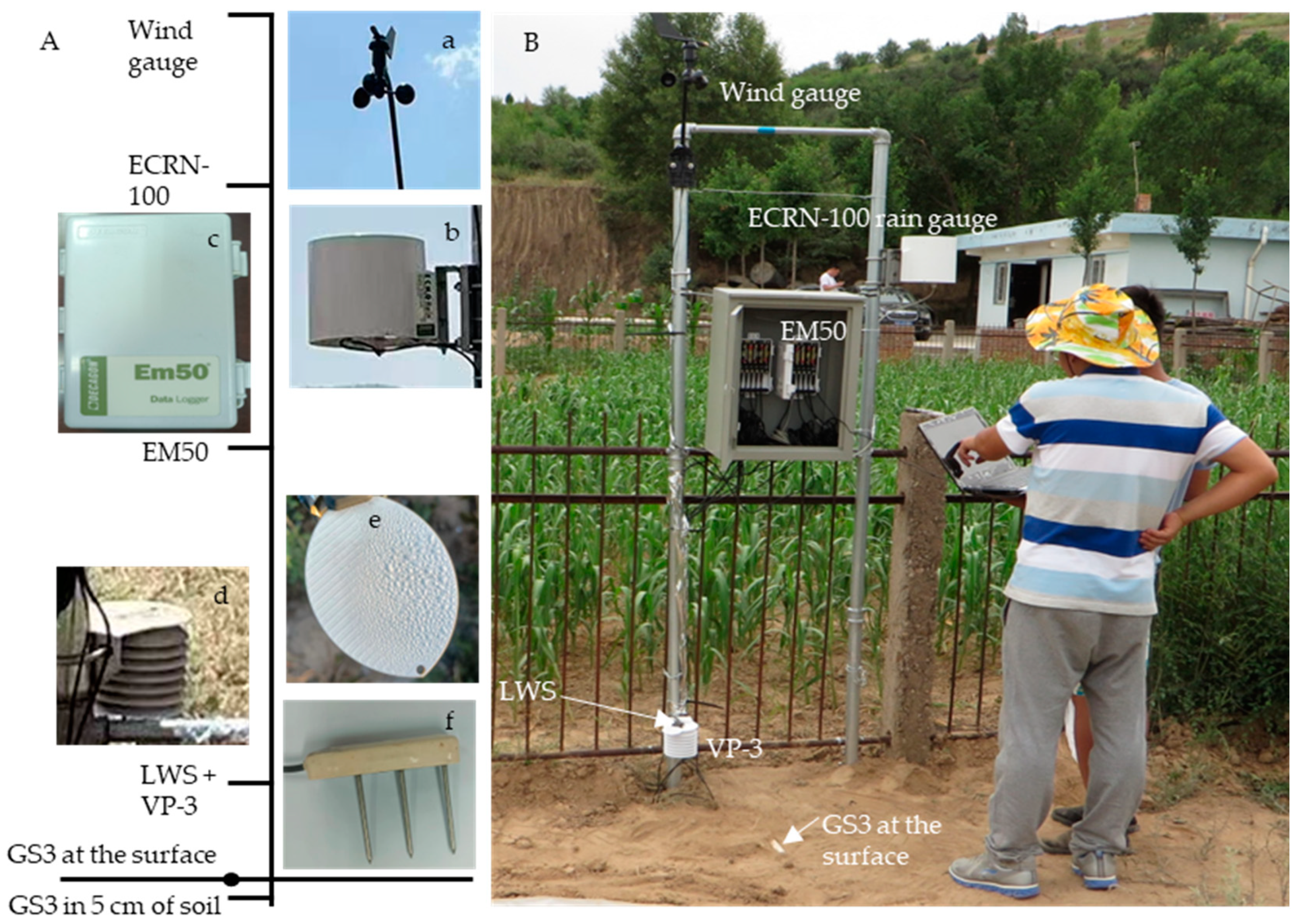
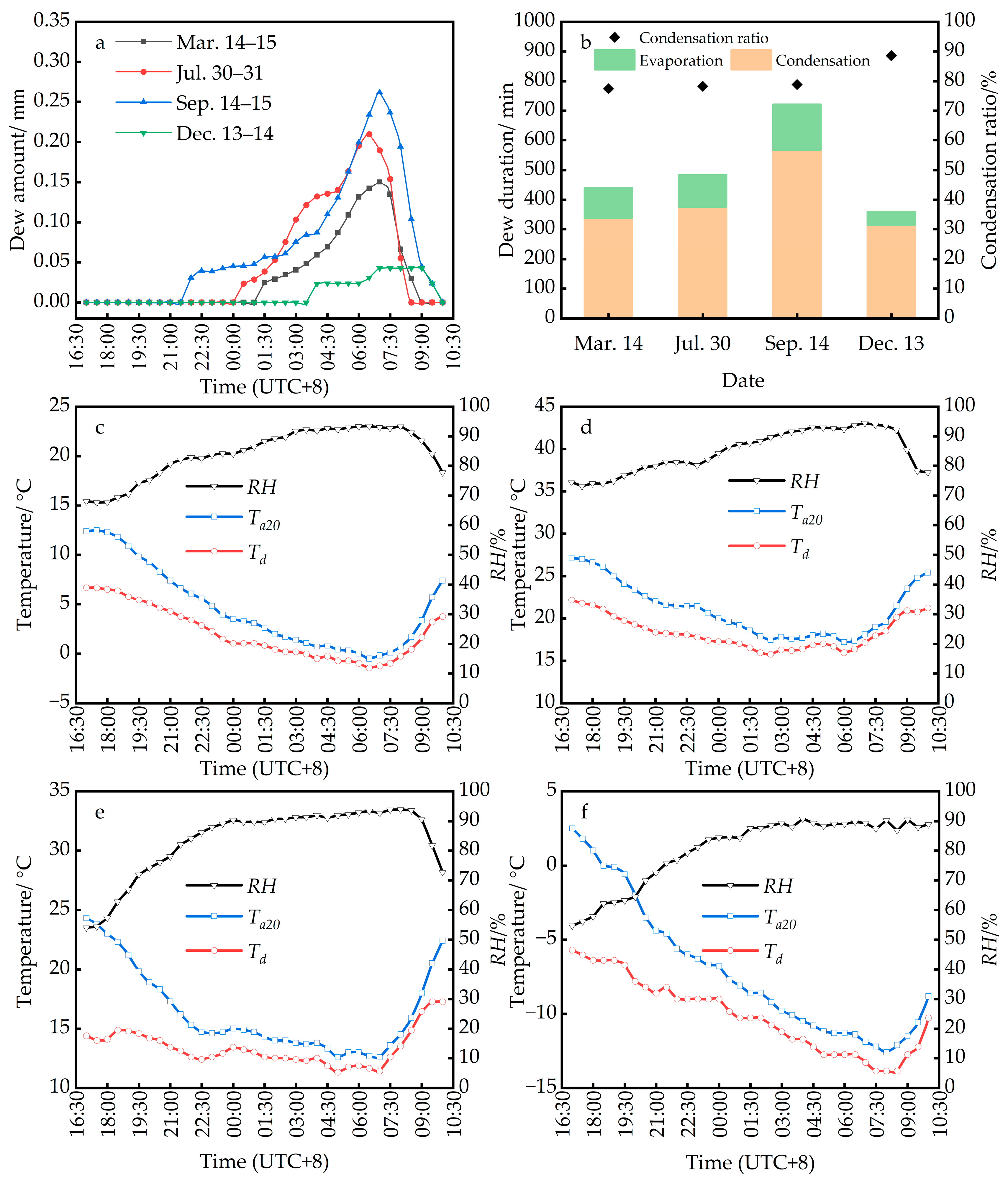


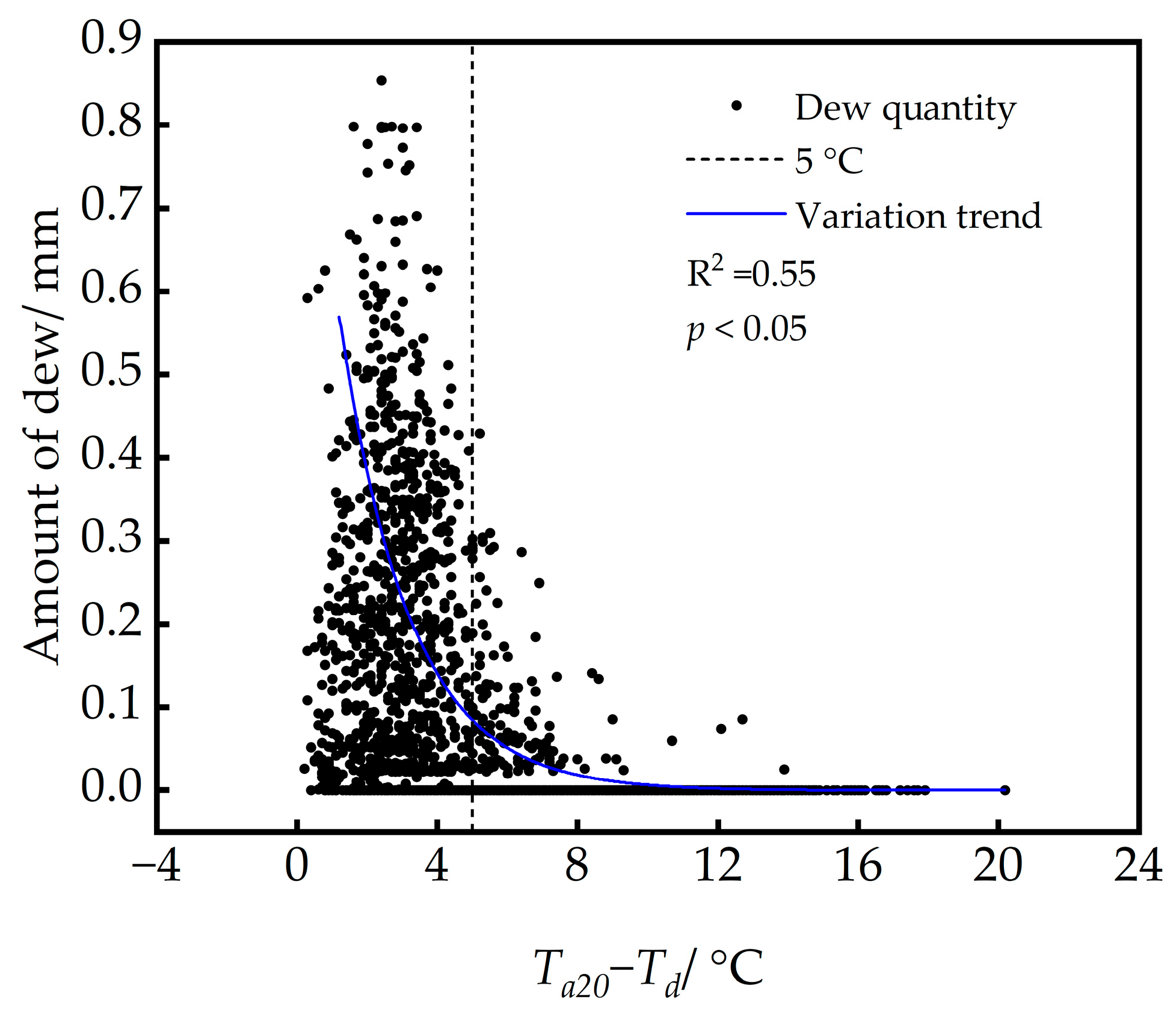

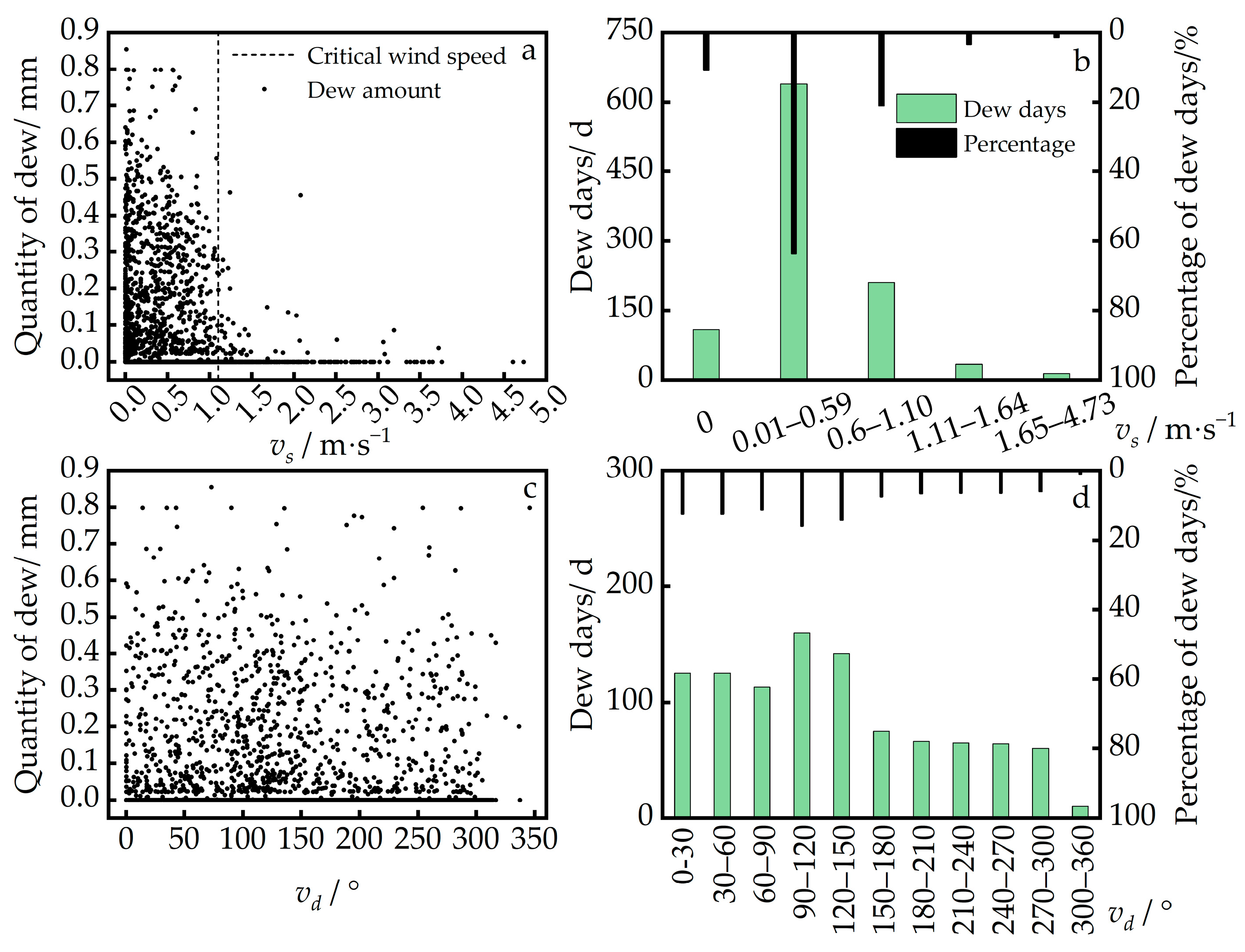
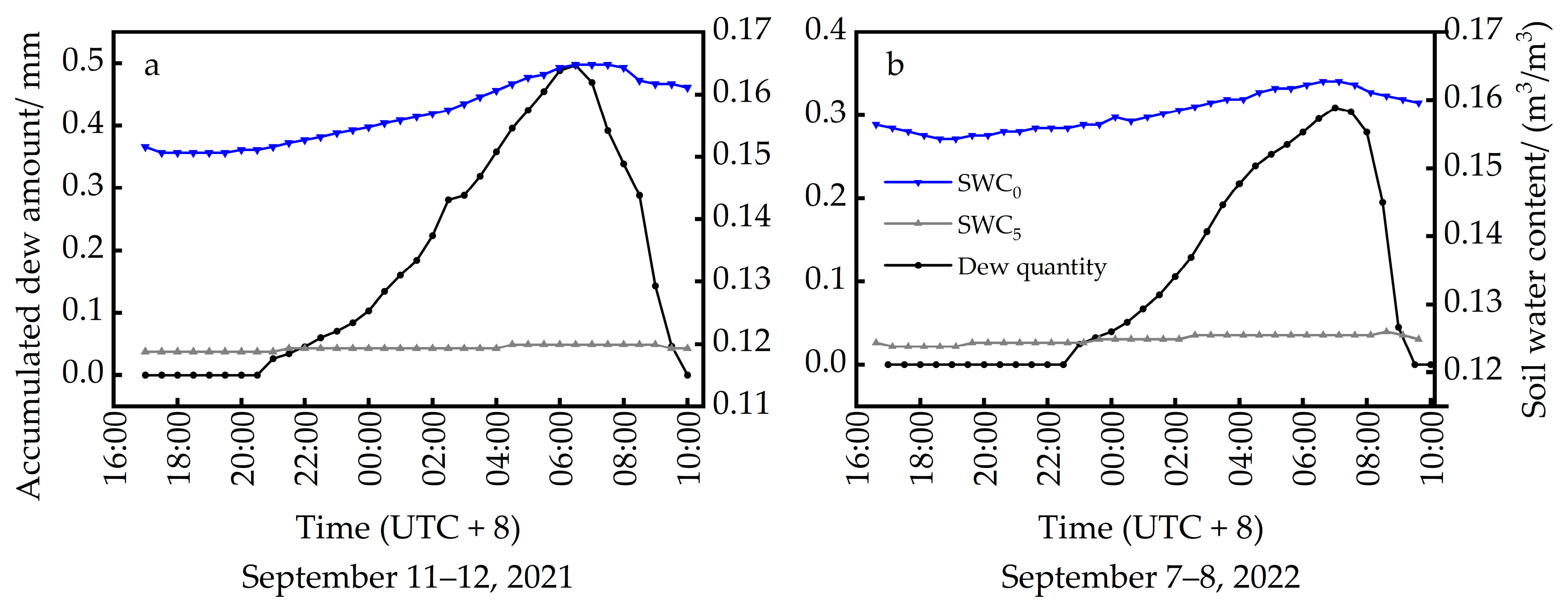

| Instrument | Installation Height | Monitoring Index and Unit | Measurement Accuracy |
|---|---|---|---|
| Wind gauge | 200 cm | vs, m∙s−1; vd, ° | vs: ±0.45 m∙s−1; vd: ±1° |
| ECRN-100 | 160 cm | Precipitation, mm | ±0.2 mm |
| LWS | 20 cm | U, mV; DT, min | U, ±1 mV; DT, ±1 min |
| VP-3 | 20 cm | Ta20, °C; RH, % | Temperature, ±0.2 °C; RH, ±0.1% |
| GS3 | 0 cm, −5 cm | Ts0, Ts5, °C; SWC0, SWC5, m3/m3 | Temperature, ±0.3 °C; SWC, ±0.02 m3/m3 |
| EM50 | 120 cm | / | / |
| Year | Dew Amount/mm | Precipitation/mm | Dew Days/d | Dew Frequency/% | Light Dew 0–0.2 mm | Heavy Dew >0.2 mm | ||
|---|---|---|---|---|---|---|---|---|
| Days | Frequency/% | Days | Frequency/% | |||||
| 2016 | 25.66 | 521.6 | 145 | 39.62 | 84 | 57.93 | 61 | 42.07 |
| 2017 | 27.02 | 600.4 | 132 | 36.16 | 69 | 52.27 | 63 | 47.73 |
| 2018 | 24.23 | 564.2 | 148 | 40.55 | 101 | 68.24 | 47 | 31.76 |
| 2019 | 38.97 | 646.2 | 147 | 40.27 | 71 | 48.30 | 76 | 51.70 |
| 2020 | 30.38 | 721.6 | 152 | 41.53 | 89 | 58.55 | 63 | 41.45 |
| 2021 | 28.28 | 695.8 | 149 | 40.82 | 101 | 67.79 | 48 | 32.21 |
| 2022 | 29.84 | 742.6 | 132 | 36.16 | 71 | 53.79 | 61 | 46.21 |
| Mean ± SD | 29.20 ± 4.83 | 641.8 ± 77.1 | 143.6 ± 8.2 | 39.30 ± 2.22 | 83.7 ± 13.9 | 58.12 ± 7.59 | 60 ± 9.9 | 41.88 ± 7.59 |
| Year–Month | Simulated Emi/mm | Measured Dmi/mm | NRMSD | Simulated Dew Days/d | Measured Dew Days/d |
|---|---|---|---|---|---|
| 2022–1 | 0.37 | 0.05 | 1.49 | 5 | 3 |
| 2022–2 | 0.36 | 0.08 | 1.22 | 3 | 3 |
| 2022–3 | 0.84 | 0.88 | 0.19 | 4 | 5 |
| 2022–4 | 0.91 | 1.46 | 0.20 | 6 | 5 |
| 2022–5 | 1.22 | 1.68 | 0.21 | 8 | 8 |
| 2022–6 | 1.16 | 1.49 | 0.26 | 11 | 11 |
| 2022–7 | 3.78 | 6.14 | 0.33 | 20 | 16 |
| 2022–8 | 3.75 | 4.64 | 0.35 | 20 | 18 |
| 2022–9 | 5.01 | 7.62 | 0.20 | 22 | 24 |
| 2022–10 | 4.14 | 3.42 | 0.24 | 20 | 21 |
| 2022–11 | 2.94 | 2.36 | 0.36 | 17 | 17 |
| 2022–12 | 0.79 | 0.02 | 3.07 | 8 | 1 |
| Total | 25.27 | 29.84 | 0.17* | 144 | 132 |
Disclaimer/Publisher’s Note: The statements, opinions and data contained in all publications are solely those of the individual author(s) and contributor(s) and not of MDPI and/or the editor(s). MDPI and/or the editor(s) disclaim responsibility for any injury to people or property resulting from any ideas, methods, instructions or products referred to in the content. |
© 2024 by the authors. Licensee MDPI, Basel, Switzerland. This article is an open access article distributed under the terms and conditions of the Creative Commons Attribution (CC BY) license (https://creativecommons.org/licenses/by/4.0/).
Share and Cite
Jia, Z.; Chang, Y.; Liu, H.; Li, G.; Guan, Z.; Zhang, X.; Xi, R.; Liu, P.; Liu, Y. Characteristics and Estimation of Dew in the Loess Hilly Region of Northern Shaanxi Province, China. Sustainability 2024, 16, 2482. https://doi.org/10.3390/su16062482
Jia Z, Chang Y, Liu H, Li G, Guan Z, Zhang X, Xi R, Liu P, Liu Y. Characteristics and Estimation of Dew in the Loess Hilly Region of Northern Shaanxi Province, China. Sustainability. 2024; 16(6):2482. https://doi.org/10.3390/su16062482
Chicago/Turabian StyleJia, Zhifeng, Yingjie Chang, Hao Liu, Ge Li, Zilong Guan, Xingchen Zhang, Ruru Xi, Pengcheng Liu, and Yu Liu. 2024. "Characteristics and Estimation of Dew in the Loess Hilly Region of Northern Shaanxi Province, China" Sustainability 16, no. 6: 2482. https://doi.org/10.3390/su16062482
APA StyleJia, Z., Chang, Y., Liu, H., Li, G., Guan, Z., Zhang, X., Xi, R., Liu, P., & Liu, Y. (2024). Characteristics and Estimation of Dew in the Loess Hilly Region of Northern Shaanxi Province, China. Sustainability, 16(6), 2482. https://doi.org/10.3390/su16062482








